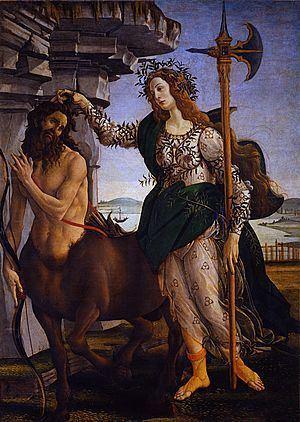Year c. 1482 Period Early renaissance | Medium Tempera on canvas Created 1482 | |
 | ||
Dimensions 204 cm × 147.5 cm (80 in × 58.1 in) Similar Sandro Botticelli artwork, Early renaissance artwork | ||
Pallas and the centaur by botticelli
Pallas and the Centaur is a painting by the Italian Renaissance painter Sandro Botticelli, c. 1482. It is housed in the Uffizi of Florence. The painting was discovered in 1895 in one of the ante-rooms of the Palazzo Pitti by William Blundell Spence. It has been proposed as the companion piece to Primavera and interpreted as an allegory on the peace after the Pazzi wars.
Contents
Artist
Born in 1444, March 1, Botticelli’s birth given name was Alessandro di Mariano di Vanni Filipepi. Botticelli had a brother named Antonio who was a goldsmith that helped Botticelli learn design. Sandro Botticelli took on this alias and studied art under artists Fra’ Filippo Lippi (1406-1469) and Masaccio (1401-1428). Masaccio was a “Quattrocento master” – Quattrocento being the overall artistic and cultural events that occurred in the 15th century - and he heavily influenced Botticelli’s style when Botticelli created his own art studio. He took in Lippi’s son, Filippino Lippi, as an apprentice and helped him to create “The Adoration of the Kings.”
This painting marked the end of his time painting for the Medici family as his artworks shifted toward more religious subject matters. He began to follow a Dominican friar named Savonarola, which helped cause this religious shift.
As years went on, he became a less famous artist and he became sad and depressed. He never married, preferring to spend time with his family and friends instead. Botticelli died on May 7, in 1510.
Details
The medium used is tempera paints on canvas and its size is 207x148 cm. The painting itself mainly depicts Pallas holding the hair of a centaur although it is argued whether the woman is Pallas Athene or Amazon Camilla. The centaur – a being associated with lust and sensuality - cowers in fear of Pallas as she holds the beast by its long hair, helping confirm that the painting is conveying the idea that sensuality is not above virtue.
Depicted in this painting, Pallas is wearing draped, clinging clothing with the three ring insignia of the Medici family on it, confirming that the painting was made for the Medici family. Her clothes also include olive branches entwined around her arms and chest and she even has a crown of olive branches. The olive branches on her chest are acting almost as armor as well as representing the goddess of wisdom Athene, which helps the argument that the woman depicted is the goddess Pallas Athene. Pallas also is holding a halberd in her left hand, which could represent the goddess’s spear that she usually is depicted with. On her back is a shield and she wears leather sandals on her feet.
History
It was commissioned by the Medici family, as were many of Botticelli’s paintings, and is currently being held in the Uffizi museum – the oldest museum in Florence, Italy. In 2015, this painting among other Botticelli paintings was in an exhibit that traveled to Japan from Berlin. It showcased Botticelli’s works and other artists’ renditions of his paintings such as his “The Birth of Venus” and “Venus from the Waves.”
There was a novel written about it by Laura Proud which describes Botticelli, this painting, and its possible interpretations. There have also been many pop culture references to some of Botticelli’s paintings including a dress worn by Lady Gaga that showed Botticelli’s painting “Birth of Venus”.
The painting – Pallas and the Centaur - was entered into and displayed in the Uffizi gallery in 1922. Other pieces of Botticelli’s from his religious period are also in the Uffizi museum such as “Madonna the Magnificent.”
Interpretations
A possible interpretation of the painting is that Lorenzo di’ Medici – the main commissioner of this artwork - is represented by Pallas as he is overcoming the greed surrounding him - represented by the centaur – when he approaches Naples by boat to surrender during the Pazzi War.
Pallas is shown to be a figure of reason, restraining the beast of our nature - also represented by the centaur - by the hair and looking at it with no fear. This helps to demonstrate Sigmund Freud’s theory of the unconscious.
Botticelli’s idea for the painting could have come from a work made for a Roman calendar in 354 A.D. by Furius Dionysius Philocalus, the secretary to Pope Damasus I. The calendar depicts a female warrior with a spear and shield holding the hair of a male figure with a bow and arrows by his feet. The male is smaller than the female and looks as if he is trying to escape her grasp. The two works are very similar and it is possible Botticelli got his idea for his painting from this calendar piece.
